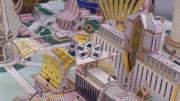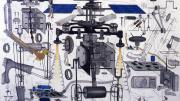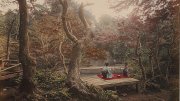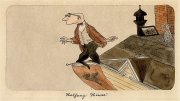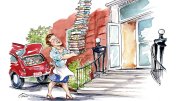The Ethelbert Cooper Gallery of African & African American Art glows at night—a lantern of lit cedar against the dense red brick of Mount Auburn Street. Visitors get their first look into the building through slices of glass, between tall cedar slats. The architect, W.E.B. Du Bois medalist David Adjaye, built the gallery’s façade to resemble a forest; its doors, also glass, form a clearing that welcomes people in.
“Wood and water are the critical materials of the Middle Passage story,” Adjaye said at a panel discussion in late October, introducing the new addition to Harvard’s Hutchins Center for African and African American Research. They are, he added, “totemic” of the history between Africa and America. When considering how best to add to what he called the “perfect urban set piece” of Harvard, Adjaye resolved to build a façade that expressed a civic spirit. He wanted something visibly distinct and slightly removed from its neighbors’ commercial traffic; nothing that resembled a “lobby for an office building.”
Adjaye’s forest is nevertheless an unlikely face for the exhibit within, which explores Africa’s urban spaces. It’s possible to glimpse, through all that timber, the pastel and metallic spires of a miniature cityscape. This sculpture (see image gallery, above) starts off Luminós/C/ity.Ordinary Joy: From the Pigozzi Contemporary African Art Collection (on view until January 8, 2015), curated by Adjaye alongside Mariane Ibrahim-Lenhardt, founder and director of the M.I.A. Gallery in Seattle, and the Cooper Gallery’s director, Vera Ingrid Grant. “A lot of joy” went into this exhibit, says Grant.
The first of 98 works by 21 artists, the paper and mixed media sculpture by the Kinshasa-based artist Bodys Isek Kingelez presents a fantasy metropolis. Above the reception desk hangs a commentary by his late countryman, Moké: the painting, Kingelez Starting Out, depicts the artist sitting in a village square, in a tattered school uniform long outgrown. Grandiose architectural models stand in front of the shells of wrecked cars; the schoolchildren in the background barely seem to notice either Kingelez or his paper dreams.
The lobby’s staging teaches the visitor how to proceed through the rest of the gallery’s eight spaces, which the curators call “neighborhoods” or “scenarios”—attuned to how pieces echo and rebut one another. A gallery of photographs by Philip Kwame Apagya is accompanied by a backdrop depicting Manhattan, inviting visitors to pose for selfies. After a room full of the nightmarish machine diagrams of Abu Bakarr Mansaray comes the playful sight of a wood-and-rope bicycle, created by Titos Mabota and towering nearly eight feet tall.
Rather than engineer a linear narrative, flowing from the Mount Auburn Street doors to those on Eliot Street, the curators reserved the rear exit for emergency use only. Visitors, halted, find they must retrace their path to leave the gallery. They may bump into one another on their way; they may be confronted by works on walls that they’d accidentally passed over. Retracing their steps may spark new connections between works. Seen from the back, the rooms frame the art in different ways. A video by Nandipha Mntambo, in which she outfits herself as a bullfighter and grandly enters an empty stadium, now foregrounds the satirically monumental Kudzanai Churai portraits in the neighboring room. Two masks—one welded out of decommissioned arms by Gonçalo Mabunda; another, by Romuald Hazoumé, combining a TV monitor and plastic gasoline can—stare each other down.
The works on display represent only a sliver of Jean Pigozzi’s total collection of around 12,000 artworks, housed in Geneva. Adjaye, Ibrahim-Lenhardt, and Grant wanted to leave each of their selections plenty of breathing room, explains the director. Against the gallery’s dark gray walls, the presentation of the pieces is spare; only the more sensitive paper sculptures stand behind glass. The rest remain out in the open, a decision negotiated at length with their collector himself. As Pigozzi and his staff from the Contemporary African Art Collection toured the exhibit, however, they came to appreciate the effect of this exposure, Grant recalls.
The labeling was also kept minimal. “People bring their own intelligence to visual culture,” she says. “Having screens and veils and filters on the art is something we wanted to dispense with. We have no acrylic barriers, so why have textual ones?”
As host of the panel discussion and founding director of the Hutchins Center, Fletcher University Professor Henry Louis Gates Jr. told the audience the gallery’s creation story, one that harkened back to the night he first showed donor Ethelbert Cooper the place that could bear his name, peering through the darkened windows in an icy December rain. “I mean, who says that there aren’t miracles, right?” Gates asked, to general applause.
That story has yet to arrive at an ending. “We are still grappling with how the space can receive art,” says Grant. The gallery awaits some finishing touches: the integration of its media systems; carpets that need smoothing out; at the Eliot Street door, a lone row of shelving that the staff decided “doesn’t work” and must come down. She anticipates that “This will be a test year for us.”
The Cooper Gallery is open Wednesday through Saturday. Luminós/C/ity.Ordinary Joy will remain on view until January 8, 2015. In the spring, it will be replaced by a traveling exhibit, Drapetomanía: Grupo Antillano and the Art of Afro-Cuba, curated by Bliss professor of Latin American history and economics Alejandro de la Fuente.
